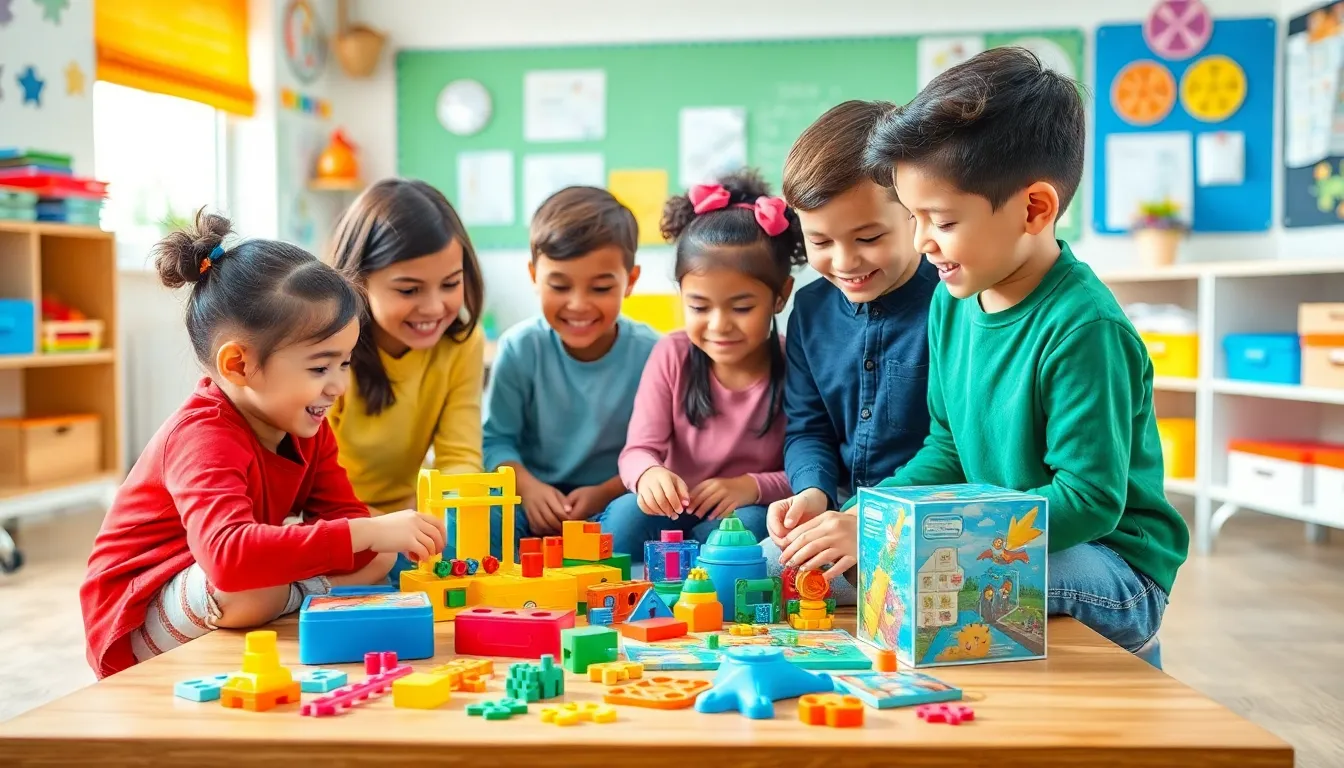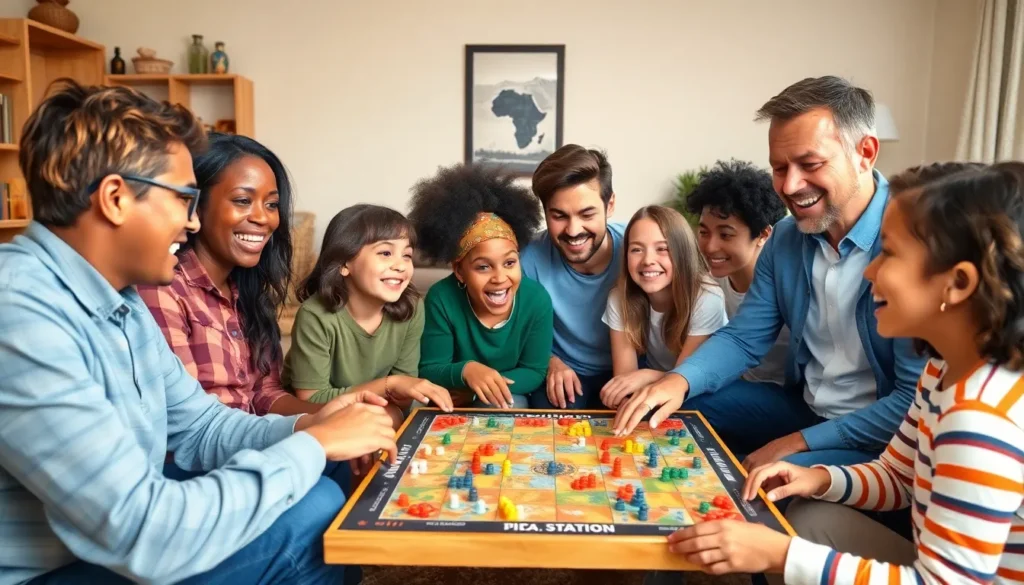Game toys have taken the world by storm, transforming playtime into an epic adventure. These aren’t just your average action figures or plush companions; they’re the key to unlocking creativity, teamwork, and a whole lot of fun. Imagine a world where kids and adults alike can dive into thrilling quests, build their own empires, or even save the universe—all from the comfort of their living rooms.
With a plethora of options available, game toys cater to every taste and age group. Whether it’s a high-stakes board game or an interactive gadget that responds to your every move, these toys are designed to keep players engaged and entertained. So, why settle for mundane when you can elevate playtime to legendary status? Let’s explore the fascinating universe of game toys and discover why they’re the ultimate addition to any playroom.
Overview of Game Toys
Game toys represent a vibrant category in the toy marketplace, captivating users of all ages. These products encourage social interaction, creativity, and problem-solving. Board games exemplify classic game toys that unite families and friends around a shared experience. Meanwhile, interactive gadgets, such as electronic games, provide engaging challenges that stimulate cognitive development.
Many game toys are designed with inclusivity in mind, allowing various age groups to play together seamlessly. For instance, cooperative games require teamwork, fostering strengthened social bonds among players. Diverse themes and formats ensure there’s something for everyone, ranging from strategy-based challenges to artistic endeavors.
Game toys also influence educational growth. They incorporate essential skills like critical thinking and decision-making while providing enjoyable playtime. Additionally, many game toys align with educational standards, delivering a fun learning experience. Popular choices like card games and puzzles enhance memory and concentration as well.
Emerging trends demonstrate the continuous evolution of game toys. Hybrid forms that blend digital elements with traditional gameplay gain traction in today’s tech-savvy landscape. Many innovations cater to the modern consumer’s desire for multifunctional, engaging experiences. With the right game toy, families can create lasting memories while enjoying an adventure.
Types of Game Toys

Game toys fall into several distinct categories, each offering unique ways to explore creativity and foster skills.
Educational Game Toys
Educational game toys integrate learning with fun. They cover subjects like math, science, and language arts while engaging children through play. Products like STEM kits promote hands-on experimentation, helping kids understand complex concepts. Games encouraging critical thinking, such as puzzles and strategy-based challenges, enhance cognitive skills. Manufacturers design these toys to meet educational standards, often aligning with curriculum goals. The interactive nature of educational toys allows children to grasp knowledge while enjoying themselves.
Traditional Game Toys
Traditional game toys have stood the test of time. Board games represent a classic example, uniting family and friends for hours of fun. Well-known titles like Monopoly and Scrabble foster social interaction and strategic thinking. Card games, another form of traditional toys, bring excitement and engagement to gatherings. These toys, with their simple rules and easy setup, appeal to players of all ages. The nostalgic charm of traditional game toys continues to create memorable experiences and lasting bonds.
Electronic Game Toys
Electronic game toys embrace modern technology in play. Console games attract enthusiasts with immersive experiences and captivating graphics. Mobile apps offer accessible gameplay on the go, providing entertainment through interactive challenges. Many electronic toys encourage social connectivity, allowing players to engage with others worldwide. Some products blend digital and physical elements, creating hybrid gaming experiences that enhance creativity. This innovative approach keeps electronic game toys at the forefront of the gaming industry.
Benefits of Game Toys
Game toys offer numerous benefits, transforming playtime into educational and social experiences. They promote various skills essential for development.
Cognitive Development
Game toys enhance cognitive abilities by challenging players to think critically and make decisions. Engaging in problem-solving activities stimulates mental processes. Board games, for example, often require strategizing, which strengthens analytical skills. Many games also incorporate math and logic, helping children grasp essential concepts. Additionally, emerging hybrid game toys blend digital interfaces with traditional gameplay, fostering adaptability in players. Regular interaction with game toys encourages players to think creatively, sharpening their cognitive skills over time.
Social Interaction
Game toys serve as vital tools for social interaction, bringing people together through shared experiences. Family game nights create bonds and foster communication as players strategize and negotiate. Cooperative games emphasize teamwork, teaching individuals how to collaborate effectively. They allow players of different ages to engage, promoting inclusivity. Regular participation in these activities enhances social skills, such as empathy and conflict resolution. Moreover, game toys often encourage respect for others, enhancing social responsibility among players. Overall, game toys create memorable moments that strengthen relationships and improve social interactions.
Popular Game Toys on the Market
Classic board games remain a favorite among families, with titles like Monopoly, Scrabble, and Settlers of Catan providing hours of entertainment. These games promote friendly competition and strategic thinking, making them staples for game nights.
Interactive gadgets appeal to tech-savvy players, with options like LEGO Boost and Osmo blending physical play with digital interaction. These toys encourage creativity while enhancing problem-solving skills.
Educational game toys have emerged as vital tools for learning, often covering subjects like math and science through engaging gameplay. Examples include Rush Hour, which develops critical thinking, and Gravity Maze, which fosters spatial reasoning. Many parents appreciate these products for their ability to combine fun with academic growth.
Electronic game toys now dominate the market, featuring consoles like Nintendo Switch and PlayStation 5. These platforms offer immersive experiences through multiplayer games that encourage social connectivity.
Cooperative games attract players looking for shared goals rather than competition. Titles such as Pandemic and Forbidden Island challenge groups to work together, nurturing teamwork and collaboration skills.
Gaming kits provide hands-on experiences, appealing to those who enjoy crafting or building. Robotics kits and STEM-focused sets offer children and teens practical, educational play that stimulates interest in technology and engineering.
Overall, the variety of game toys available satisfies diverse interests among children and adults alike. Each option contributes to skill development while providing memorable experiences, making game toys invaluable for playtime.
Conclusion
Game toys have carved out a significant niche in the toy market by offering engaging and educational experiences for all ages. Their ability to foster creativity teamwork and critical thinking makes them essential tools for both play and learning. As trends evolve game toys continue to adapt blending traditional elements with modern technology to enhance user experience.
Families and friends can bond over classic games while interactive gadgets stimulate cognitive development. The diverse range of options ensures that there’s something for everyone whether it’s a strategic board game or an innovative electronic toy. Game toys are more than just playthings; they’re valuable resources that enrich lives and create lasting memories.



